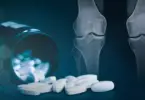By Sayer Ji
Guest Writer for Wake Up World
Turmeric is one of the most popular herbal supplements in the world. This highly prized spice is valued for its rich color and flavor profile, both the result of high concentrations of curcumin, a plant polyphenol that also imparts therapeutic antioxidant properties.
[pro_ad_display_adzone id=”110028″]
A natural antidote to inflammation, supplements made from curcumin are popular among athletes and active adults seeking alternatives to non-steroidal anti-inflammatory drugs (NSAIDs) — and with good reason. Curcumin is clinically proven to reduce post-workout soreness caused by muscle damage and inflammation.[i]
But how does turmeric rate against the effects of chronic pain? According to recent studies, the anti-inflammatory power of turmeric stands up against popular NSAID drugs, without potentially toxic side effects.
Chronic Pain Affects 1 in 5 Adults
Although estimates vary, chronic pain is believed to affect more than 20% of U.S. adults[ii] and is a virulent symptom of articular joint disease. Pain can derive from structural changes within the joint, such as destruction of bone and protective cartilage, and the development of adhesions that interfere with joint movement. Pain can also result from chronic inflammation in and around the joint and surrounding ligaments and tendons.
Arthritis is a general term for any type of inflammatory joint condition.[iii] Osteoarthritis, often referred to as “wear and tear disease,” is the most common articular disease leading to chronic pain and severe disability.[iv] The effectiveness of curcumin supplementation for joint protection is well documented, with ongoing studies on this herbal therapeutic as a treatment for chronic pain associated with articular disease.
Arthritis: A Common Cause of Chronic Pain
In 2020, researchers investigating treatments for osteoarthritis explored co-supplementation of curcumin enhanced by gingerols and piperine, the active ingredients of ginger and black pepper, for their ability to boost and sustain the anti-inflammatory effects of curcumin. The analgesic and anti-inflammatory powers of this herbal formulation were compared against those of Naproxen, a commonly dispensed NSAID drug.
Sixty patients with mild-to-moderate osteoarthritis of the knee were studied, with individuals randomly assigned to receive the herbal blend or Naproxen capsules, twice daily for four weeks. The biomarker prostaglandin E2 (PGE2), a molecule that regulates immune system function and inflammation, was assessed along with daily recall of pain level. All patients successfully completed the study.
Results showed that pain and PGE2 decreased significantly in both groups.[v] Unlike Naproxen, which has potentially serious side effects, curcumin supplementation is nontoxic and “Generally Recognized As Safe” (GRAS) by the FDA, even at high doses.[vi] The black box warnings for Naproxen stand in sharp contrast, with serious risks including headache, stomach pain, chest tightness, difficulty breathing, severe and continued nausea, blindness, coma and overdose, to name just a few.[vii]
Turmeric Reduces Inflammatory Joint Pain
Another recent study on the analgesic effects of turmeric for knee joint pain once again proved that turmeric is worthy of its golden reputation. In a pilot, randomized clinical trial, 68 patients with mild-to-moderate knee joint pain consumed either a turmeric extract (TE) formulation or brewer’s yeast placebo for one week. After 10 days, results were compiled showing that both TE and placebo reduced pain when patients walked on a flat surface, went up or down stairs, and when sitting or lying down.[viii]
Only the TE group reported reduced pain at night while in bed and when standing upright.[ix] Ratings for knee joint pain were reduced in both groups after three days and one week of intervention, indicating efficacy over a three to seven-day period, with the TE group reporting the least amount of global pain.[x]
This short-term analgesic effect lasted from three days to one week post-treatment. Turmeric-treated patients were the only group with decreased C-reactive protein levels, indicating a fast-acting pain-relieving effect that is mediated by decreased inflammation.[xi]
Turmeric to Reduce Inflammation and Pain
With studies showing that commonly prescribed arthroscopic knee surgery is no better than placebo when it comes to managing chronic pain,[xii] it’s time for safe, effective therapies to replace unnecessary medical care. Turmeric or curcumin supplementation delivers strong antioxidant properties with impressive anti-inflammatory and pain-relieving effects that are consistently validated by science.[xiii]
It’s never too late to begin a supplement regimen, with some studies suggesting that curcumin may contribute to the regeneration of healthy cartilage.[xiv] If you’re considering adding this powerful herb to your dietary regimen, recognize that turmeric is the whole spice, which can be consumed in relatively high doses through foods, however curcumin supplements are the concentrated form of one of turmeric’s active ingredients, therefore curcumin may provide additional therapeutic effects.
A successful clinical trial on curcumin for osteoarthritis pain found that 500 milligrams taken twice daily for two to three months had optimal effects on participants’ pain levels. To learn more about nontoxic pharmaceutical alternatives, consult GreenMedInfo.com, the world’s most widely referenced, evidence-based natural medical resource.
To learn more about the incredible health benefits of turmeric, visit the GreenMedInfo database on this wonderful root here.
References:
[i] J Nutr Sci Vitaminol (Tokyo). 2019;65(1):82-89. doi: 10.3177/jnsv.65.82. PMID: 30814417
[ii] PAIN February 2022, Volume 163, Issue 2, p e328-e332 https://journals.lww.com/pain/Abstract/2022/02000/Prevalence_of_chronic_pain_among_adults_in_the.31.aspx
[iii] Britannica, Science, Joint Disease, https://www.britannica.com/science/joint-disease
[iv] Phytother Res. 2020 Aug;34(8):2067-2073. doi: 10.1002/ptr.6671. Epub 2020 Mar 16. PMID: 32180294
[v] Phytother Res. 2020 Aug;34(8):2067-2073. doi: 10.1002/ptr.6671. Epub 2020 Mar 16. PMID: 32180294
[vi] Foods. 2017 Oct 22;6(10):92. doi: 10.3390/foods6100092. PMID: 29065496; PMCID: PMC5664031
[vii] Mayo Clinic, Drugs and Supplements, Naproxen (Oral Route, https://www.mayoclinic.org/drugs-supplements/naproxen-oral-route/side-effects/drg-20069820
[viii] J Med Food. 2021 Apr;24(4):436-440. doi: 10.1089/jmf.2020.0074. Epub 2020 Jul 29. PMID: 32749918; PMCID: PMC8080919.
[ix] J Med Food. 2021 Apr;24(4):436-440. doi: 10.1089/jmf.2020.0074. Epub 2020 Jul 29. PMID: 32749918; PMCID: PMC8080919.
[x] J Med Food. 2021 Apr;24(4):436-440. doi: 10.1089/jmf.2020.0074. Epub 2020 Jul 29. PMID: 32749918; PMCID: PMC8080919.
[xi] J Med Food. 2021 Apr;24(4):436-440. doi: 10.1089/jmf.2020.0074. Epub 2020 Jul 29. PMID: 32749918; PMCID: PMC8080919.
[xii] BMJ 2015;350:h2747 https://www.bmj.com/content/350/bmj.h2747
[xiii] Int J Pharm Investig. 2014 Jul ;4(3):138-41. PMID: 25126527 [xiv] Open Rheumatol J. 2014 ;8:77-81. Epub 2014 Oct 17. PMID: 25352926
About the author:
Sayer Ji is the founder of Greenmedinfo.com, a reviewer at the International Journal of Human Nutrition and Functional Medicine, Co-founder and CEO of Systome Biomed, Vice Chairman of the Board of the National Health Federation, and Steering Committee Member of the Global Non-GMO Foundation.
© 2020 GreenMedInfo LLC. This work is reproduced and distributed with the permission of GreenMedInfo LLC. Want to learn more from GreenMedInfo? Sign up for their newsletter here.
[pro_ad_display_adzone id=”110027″]









